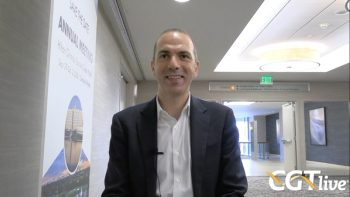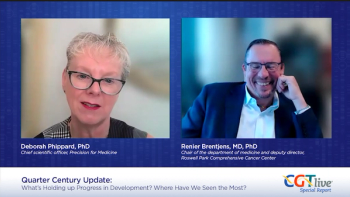
Gene Therapy Voretigene Neparvovec Increases Light Sensitivity in RPE65-IRD via Peripheral Cone Function Improvements
Bart P. Leroy, MD, PhD, head of the Department of Ophthalmology at the Center for Medical Genetics of Ghent University Hospital, discussed new real world data regarding Spark Therapeutics’ Luxturna that was presented at ARVO’s 2023 conference.
This is the second part of a Q&A with Bart P. Leroy, MD, PhD. For the first part,
Spark Therapeutics’ voretigene neparvovec (Luxturna) is a marketed gene therapy intended to treat patients with inherited retinal dystrophy (IRD) related to mutations in the RPE65 gene. Prior to its approval by the FDA and the European Medicines Agency, it was evaluated in a pivotal phase 3 clinical trial (NCT00999609). The results of the trial included improvements in light sensitivity observed among the patients treated with the gene therapy; however, no significant improvement in best-corrected visual acuity (BCVA) was obtained.
Several postmarketing studies have since been launched to verify these results in real world settings. One such study,
CGTLive™ spoke with Bart P. Leroy, MD, PhD, the head of the Department of Ophthalmology at the Center for Medical Genetics at Ghent University Hospital, who coauthored the poster, to discuss the main implications of the findings from this postmarketing study. He emphasized that the findings are consistent with the previous clinical trial results and spoke about how the improvements observed in light sensitivity relate to improvements in quality of life for the patients. Leroy also touched on the reasons why improvements in BCVA are likely not effected by voretigene neparvovec.
CGTLive: What would you say are the main implications or takeaways of the data your team presented at ARVO 2023?
Bart P. Leroy, MD, PhD: The first thing we can do is confirm that in a real world setting the results of the phase 3 trial, the pivotal trial for market authorization for Luxturna, are just confirmed. So that is a good thing. It's not surprising, but it's a good thing that in the real-world setting, we can confirm the effects. We've never promised our patients that there would be a considerable improvement in BCVA, but what we did say is: This treatment is not going to resuscitate the quality of the retina, it's not going to bring back all the function that you've lost—but what it's going to do is seriously increase your sensitivity to light. And that has happened, and this is mostly reflected by the full-field sensitivity testing results.
I think that that reflects to activities of daily living in the sense that patients are navigating in conditions that they were never able to see anything in before—so much so that when people now go out, during a sunny day, they start wearing sunglasses, because the intensity of the light is actually a little bit a reflection of what we have when we walk out. For example, here in New Orleans, with highly intense sunshine, I have to wear sunglasses to be comfortable, and that's what they say, as well. I think the main takeaway is: it does work, it works as intended, and there are no surprises at the level of safety as well.
Why was voretigene neparvovec expected to improve light sensitivity, but not BCVA?
From the initial phase 1 study, the phase 1 add-on study, and then the phase 3 trials that we did to get Luxturna to market, we saw that we had very little impact on the central cone function, which obviously is the function driving BCVA. The reasons why are not very clear. We have multiple hypotheses. All of the patients treated in the trials were older than 8-years-old. Obviously, at that time, you may already have a certain degree of amblyopia—that is, your brain is not geared anymore to use your fovea, or central part of your retina, to have high acuity vision. And so then, chiming in some quality at that level, you may just not have the desired effect anymore.
The light sensitivity increase comes from peripheral cone function improvements, but certainly also from improvements of the rods. Basically, I think that what we showed in the phase 1, phase 2, and phase 3 trials was that the most significant improvement was exactly that.
We also knew from studying in detail RPE65-related IRD that the function might be really bad in patients with this condition, but there is an opportunity because there is anatomy that is relatively preserved—and we could target that anatomy to just start working again. With not everything known about the function of the retina, and why exactly foveal function is not something you can have kick in, we were certainly more interested in proving that light sensitivity went up.
And to be honest, that is an incredible gain in daily life if you look at the patients and the stories they tell. Their ability to navigate in, for example, a darker stairway at school is just enormous—whereas otherwise kids had to be accompanied by people who could guide them from 1 classroom to the other, now they can all of a sudden just find their way themselves—and that does change things a lot.
Transcript edited for clarity.
REFERENCE
1. Hertens L, Cauwenbergh CV, den Broeck FV, et al. Results of Belgian patients with RPE65-related inherited retinal dystrophy 6 months after treatment with voretigene neparvovec. Presented at: Association for Research in Vision and Ophthalmology (ARVO) 2023 Annual Meeting. April 23-27, 2023; New Orleans, LA. Abstract #762 – C0363
Newsletter
Stay at the forefront of cutting-edge science with CGT—your direct line to expert insights, breakthrough data, and real-time coverage of the latest advancements in cell and gene therapy.











































